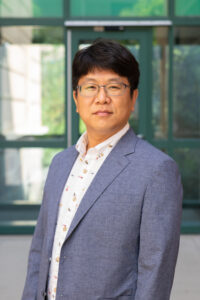 Cell-to-cell communication is a large part of Professor Dae Seok Eom’s research. In particular, the Eom lab focuses on a novel signaling projection called airinemes, which have meandering trajectories as they travel from the signal sending cell to the target cell.
Cell-to-cell communication is a large part of Professor Dae Seok Eom’s research. In particular, the Eom lab focuses on a novel signaling projection called airinemes, which have meandering trajectories as they travel from the signal sending cell to the target cell.
The unique trajectory of airinemes — observed in stripe pigment pattern formation in zebrafish — caught the attention of Sohyeon Park, first author and PhD student in the lab of Professor Jun Allard from Department of Mathematics, when she rotated in the Eom lab in Department of Developmental and Cell Biology. Park initiated the study, which relied on the collaboration between the Eom lab and the Allard lab, to understand why airinemes used this trajectory using a mathematical model.
The Allard lab and Hyunjoong Kim, a postdoc in the Department of Mathematics at the University of Pennsylvania, found the optimal curvature an airineme should take when locating its target cell and compared it to actual measurements from biological samples compiled by Eom lab PhD student Yi Wang.
What they found was the observed trajectory of the airinemes — which might appear random to the untrained eye — matched the mathematical model for optimal curvature.
“The results were quite interesting. Using mathematical modeling, we determined that, evolutionarily, cells found the most optimal curvature to find the target cell when they are intermingled with non-target cells,” said Professor Eom. “This was a successful collaboration between mathematical modeling and cell biology.”
The paper, Zebrafish airinemes optimize their shape between ballistic and diffusive search, was published by eLife and can be found here.
